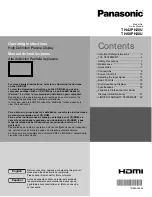
Product Specification of 42XGA PDP Module
5)
This product uses high-voltage switching and a high –speed clock. A system using this product should
be designed so that it does not affect the other systems, and should be thoroughly evaluated.
6)
This product has a glass display surface. Design your system so that excessive shock and load are not
applied to the glass. Exercise care that the vent at the corner of the glass panel is not damaged. If the
glass panel or vent is damaged, the product is inoperable.
7)
There are some exposed components on the rear panel of this product. Touching these components
may cause an electric shock.
8)
This product uses a high voltage. Design your system so that any residual voltage in this product is
dissipated quickly when power is turned off, observing the specifications.
9)
This product uses heat-emitting components. Take the heat emitted by these components into
consideration when designing your system. If the product is used outside the specified temperature
range, it may malfunction.
10)
This product uses a high voltage and, because of its compact design, components are densely
mounted on the circuit board. If dust collects on these components, it can cause short-circuiting
between the pins of the components and moisture can cause the insulation between the components
to break down, causing the product to malfunction.
11)
Regulations and standards on safety and electromagnetic interference differ depending on the country.
Design your system in compliance with the regulations and standards of the country for which your
system is intended.
12)
To obtain approval under certain safety standards (such as UL and EN), a filter that passes a shock
test must be fitted over the glass surface of the finished product. In addition, it must be confirmed
that the level of UV emissions is within the range specified by such standards.
13)
If this product is used as a display board to display a static image, “image sticking” occurs. This
means that the luminance of areas of the display that remain lit for a long time drops compared with
the luminance of areas that are lit for a shorter time, causing uneven luminance across the display.
The degree to which this occurs is in proportion to the luminance at which the display is used. To
prevent this phenomenon, therefore, avoid static images as much as possible and design your system
so that it is used at a low luminance, by reducing signal level difference between bright area and less
bright area through signal processing.
14)
Within the warranty period, general faults that occur due to defects in components such as ICs will be
rectified by LGE without charge. However, IMAGE STICKING is not included in the warranty. Repairs
due to the other faults may be charged for depending on responsibility for the faults.
15)
In case of AC PDP driving mechanism, Because the brightness of output is not always proportional to
input signals. Therefore the non-linearity of gray can occasionally be observed in certain gray levels as
well as Contour and Error Diffusion Noise can be appeared when a dark picture is on the screen
especially. These are phenomena that can be observed on the PDP driving mechanism. With simple
adjustment to picture brightness control, these can be reduced considerably.
16)
Because of the need to control the power consumption on the PDP driving mechanism, the
APL(Average Picture Level) mode was equipped. Thus, as the picture on the screen changes, there
can be slightly switched in brightness. This also is a phenomenon that can be observed on the PDP
driving mechanism.
17)
This product is designed to LGE’s “Standard” quality grade. If you wish to use the product for
applications outside the scope of the “Standard” quality grade, be sure to consult LGE in advance to
assess the technological feasibility before starting to design your system.
Design (continued)
102/148
Summary of Contents for PDP42Z5TA - 42" Plasma TV
Page 1: ......
Page 30: ...28 148...
Page 31: ...29 148...
Page 32: ...30 148...
Page 33: ...31 148...
Page 34: ...32 148...
Page 35: ...33 148...
Page 36: ...34 148...
Page 37: ...35 148...
Page 38: ...36 148...
Page 39: ...37 148...
Page 40: ...38 148...
Page 41: ...39 148...
Page 42: ...40 148...
Page 43: ...41 148...
Page 44: ...42 148...
Page 45: ...43 148...
Page 46: ...44 148...
Page 47: ...45 148...
Page 48: ...46 148...
Page 49: ...47 148...
Page 50: ...48 148...
Page 51: ...49 148...
Page 52: ...50 148...
Page 53: ...51 148...
Page 54: ...52 148...
Page 55: ...53 148...
Page 56: ...54 148...
Page 57: ...55 148...
Page 58: ...56 148...
Page 59: ...57 148...
Page 60: ...58 148...
Page 61: ...59 148...
Page 62: ...60 148...
Page 63: ...61 148...
Page 64: ...62 148...
Page 65: ...63 148...
Page 66: ...64 148...
Page 94: ...92 148...
Page 95: ...93 148...
Page 96: ...94 148...
Page 97: ...95 148...
Page 98: ...96 148...
Page 99: ...97 148...
Page 100: ...98 148...
Page 101: ...Product Specification of 42XGA PDP Module Specification For Approval 99 148...
Page 117: ...Product Specification of 42XGA PDP Module 115 148...
Page 129: ...Product Specification of 42XGA PDP Module Confidential 6 OUTLINE DRAWING Front View 127 148...
Page 130: ...Product Specification of 42XGA PDP Module Rear View 128 148...
Page 136: ...134 148...
















































